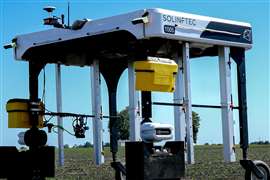Read this article in Français Deutsch Italiano Português Español
Solinftec autonomous robot, AI monitor crop changes, conditions
13 November 2024
 Solix is a four-wheeled table-like robot designed to travel autonomously through fields, monitoring and reporting on changes as they occur. (Photo: Solinftec)
Solix is a four-wheeled table-like robot designed to travel autonomously through fields, monitoring and reporting on changes as they occur. (Photo: Solinftec)
As autonomous self-propelled machines find their own path in the agricultural industry, it stands to reason that some of that equipment will not look like a traditional farm implement – many are not performing traditional farm implement tasks. Growers have seen the value data can bring to the decision-making process. The strategy has been proven through the reduction of input costs – think fuel, labor, seed and fertilizer – and now companies are developing novel ways to extract that information and present it to growers in an actionable format. Agricultural digitalization specialist Solinftec has developed an autonomous machine designed to roll through the field to monitor, record and help make decisions.
Choice Location
Founded in 2007, Solinftec (an acronym created from the words solutions, information and technology) is based in Araçatuba, Brazil, and has a US office in the Purdue Research Park in West Lafayette, Indiana – both offices were strategically positioned within crop-growing regions. Focused on supporting agriculture, the company now employs more than 700 people around the world. Its solutions reportedly cover more than 27 million acres globally.
“In Brazil, the use of digital technology in ag is booming,” said Daniel Padrão, chief operating officer, based at Solinftec’s Indiana location. “Sugar cane started to adopt this technology about 15 years ago. Today, growers can see everything that’s happening with the sugar cane they raise in Brazil. They have information from every single machine coming in every single minute. Most growers have an operational center with people watching what’s happening 24/7 and all the decisions are made based on the data that came to them without human intervention. Today, close to 90% of the sugar cane acres in Brazil are running our technology solutions because growers saw reductions in inputs close to 40%. That’s a huge improvement in the way they plant sugar.”
With its success in sugar cane, the company then looked to support crops such as soybeans, cotton and corn. “When we decided to get into row crops our goal was the same,” said Padrão. “In Brazil, the usage rates are growing. It started with the larger farmers and now it’s moving fast to the mid-size and small farmers. Farmers are seeing the benefits of these solutions and that’s why they’re adopting the technology.”
AI Machine
Much of the company’s recent success can be credited to Alice, an artificial intelligence (AI) data science assistant it introduced in 2018. A software-as-a-service platform designed to work with large-scale production growers, Alice integrates and processes data from machinery, people, weather forecasts, satellite field images and other external sources. Using edge computing and cloud-based software, the platform then delivers recommendations.
 Solix will be the eyes of Alice, Solinftec’s artificial intelligence data science assistant. (Illustration: Solinftec)
Solix will be the eyes of Alice, Solinftec’s artificial intelligence data science assistant. (Illustration: Solinftec)
“We don’t develop technology just to provide a report or to fill out a dashboard or provide a beautiful map,” said Padrão. “We have all of that, but as a byproduct. Agriculture changes all the time. If you work in an industry that changes all the time, you have to be fast. We realized we had to develop something to help our customers adapt in real time.
“To do that we had to build something that monitored what’s happening all the time and then supported customers with automation or insight to help them change their operation. Alice does that. It’s an AI-based solution that analyzes data and sends the information needed to the CEO, director, general manager and the equipment operator to help them to adapt and stay ahead of the conditions.”
While the focus is often on the growers, Padrão said the real-time data provided by Solinftec has also helped ag product retailers transform their operations. By providing a look at the total operation, the tender truck drivers, applicators, mix operators, sales agronomists, general managers, and operation teams have the information to help make daily decisions. The applicator gets real-time reports on the ideal speed of application, weather conditions, work order cycles, terrain and more.
Robotic Assistance
Alice now has a new coworker in the form of a robot named Solix. Programmed with a neurological network with a complex detection algorithm, it monitors crop health and nutrition, disease, bugs and weeds to provide real-time insights. The robot was designed in-house in partnership with universities around the world.
“The robot is the eyes of Alice,” said Padrão. “It will be in the field all day, seven days per week, running without any human intervention. It will feed Alice with much more information than is currently available from the machines and agronomists.”
“If you work in an industry that changes all the time, you have to be fast. We realized we had to develop something to help our customers adapt in real time.”
Daniel Padrão, Solinftec
While Solinftec has not yet disclosed much of the robot’s mechanical details, it is solar powered and equipped with lithium-ion batteries for energy storage. The table-like machine is designed with a high clearance to straddle crops such as corn and uses an array of cameras and sensors to monitor and detect changes in the field. Alice is embedded in the machine as well as the cloud.
“We have the robot running in Brazil, where there are a lot of challenges with connectivity. Even though we complain about cell phone coverage in U.S., it is much better here than in Brazil,” said Padrão. “However, there are many ways to solve this problem for the robot. We can store data and then send the robot to a place where it knows there will be a signal. And we are also processing a lot of things in the field, not just because of cell phone coverage but because it’s very expensive to send all the information out. We process data in the field to make faster decisions. Using edge computing and finding the right spots to send information are things the robot already does.”
Compared to tractor-mounted cameras and sensors the robot will be in the field every day, said Padrão, reporting changes as they occur, while being ground-based allows it to see below the leaf canopy better than an unmanned aerial device (UAV).
“The beauty of the robot is that it is in the field every day, not only seeing what’s happening in the field, but understanding it,” said Padrão. “With that information farmers and the retailer will know when the right time is to perform every operation. Imagine that we start the robot at the very beginning of the season to track [plant] emergence, and then we’re going to track stem count. Then we’ll keep tracking the weed pressure. With that, you’ll know the right time to dispatch the sprayer. And after you spray, we will be able to measure the result on the weed as well as the crop. Then it will keep tracking.
“Every year Alice will learn more about the farm and develop models for that specific farm. This is not something that you will get from a crop protection company; this is totally different from passing through a field once or twice a year.”
Prepared for Market
Solinftec recently announced a collaboration with Growmark which will run the robot to help fine-tune its operation for everything from planting to harvesting. An agricultural cooperative with nearly 400,000 customers across North America, the Bloomington, Illinois-based company said it saw the ag robot as a natural evolution of its trial and testing programs as well as new platforms that deliver custom solutions to customers.
“A lot of companies are developing ag robots for a specific task, such as picking strawberries or taking care of lettuce,” said Padrão. “We decided to create a robot that will not be expensive and can be set out in the field to scan non-stop.
“The partnership with Growmark is important because we don’t want to simply prove the robot in a lab or a small-scale farm. Our goal is to prove the value that we are adding to farmers and ag retailers and then take it to the market fast and scale it up it fast. Like with the speed of change we see in crops, we also know we have to aggressively develop this technology and make it fast. Our goal for this year to fine tune the technology. We will build more models if we need it and then take it market next year.”
When Solix enters production, Padrão said the company will continue to partner with a number of universities in Brazil, the U.S., and other countries for further development and manufacture.
POWER SOURCING GUIDE
The trusted reference and buyer’s guide for 83 years
The original “desktop search engine,” guiding nearly 10,000 users in more than 90 countries it is the primary reference for specifications and details on all the components that go into engine systems.
Visit Now
STAY CONNECTED




Receive the information you need when you need it through our world-leading magazines, newsletters and daily briefings.
CONNECT WITH THE TEAM














